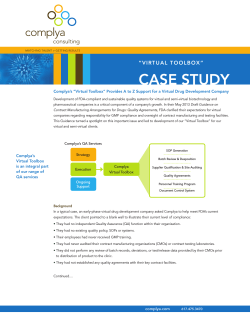
Advanced Training Agenda
QSAR APPLICATION TOOLBOX
ADVANCED TRAINING WORKSHOP
BARCELONA, SPAIN
3-4, June 2015
AGENDA
Wednesday, 3 June 2015 (09:00 – 17:30)
09:00-09:15
Registration
Welcome and Introductions/Announcements
09:15-10:00
OECD QSAR Toolbox: Description; workflows, grouping methods databases,
estimation methods and plans for future development.
The new features and functionalities in Toolbox 3.3 as compared with 3.2 are
described in the associated file.
10:00-11:00
Categorization of chemicals. Recommendations.
11:00-11:30
Coffee Break
11:30-12:00
Refreshing examples (parallel running):
Predicting acute toxicity of 3,4-Xylidene (CAS 95-64-7)
Using external profile for (non)crowded anilines
Filtering by QA and test conditions (Poecilia reticulate, Pimephales
promelas)
Demonstrating the Model domain
Using other(external) models for weights of evidence
Saving QSAR (regression) models.
12:00-13:00
Enhanced functionalities of QSAR Toolbox
Predicting genotoxicity and carcinogenicity of 3,4-Xylidene (CAS 95647)
AMES Mutagenicity (-S9, +S9)
Chromosomal aberration - (Mammalian cell gene mutation assays; In vitro
Chinese Hamster)
1
Carcinogenicity – profiling with accounting for metabolism (DNA +
Liver) – maximum values used; atom type (halogenated derivatives)
Using external models (TIMES_AMES) for collecting weights of
evidence
Save categorical models as:
SAR
Category (domain) in existing profile
Use of the new category for screening purposes
13:00-14:015 Lunch
14:15-15:30
Enhanced functionalities of QSAR Toolbox
Predicting Repeated Dose Toxicity of CAS 95-64-7 and 108-69-0
Predicting developmental and reproductive toxicity (DART model of P&G) 330-54-1
Deriving multiparametric QSARs
Import/export of QSAR (regression) models.
Structural similarity - describing the options
Scale conversion – application for combined use of data obtained by different assays
Building a new categorization profile – Manually:
Profile for crowded anilines. Application for subcategorization (CAS 9564-7)
Aldehydes. Application for screening purposes (use DSL)
Not aromatic, not alpha halogenated and
Possessing protein binding functionality (as parent and after metabolism)
Having logKow in range and size parameter in range
Reporting prediction results. Standard reports. Detailed description of
reporting settings
Toolbox Prediction Reporting Format (TPRF)
Chemical Model Reporting Format (QMRF)
Chemical Category Reporting Format (CCRF)
QMRF
Customized reports
15:30-16:00
Coffee Break
2
16:00-17:00
Enhanced functionalities of QSAR Toolbox
Import/export of data by Vertical and horizontal layouts. Building proprietary
databases (available in the Examples folder).
Export of Toolbox predictions to IUCLID5 through:
XML files
WebServices
Import of data for single chemical or multiple chemicals from IUCLID5 to
Toolbox through:
XML files
WebServices
Docking external (Q)SAR models to Toolbox:
Docking of CATALOGIC and TIMES to Toolbox
Examples of joint use of external models and Toolbox: Limonene
CC(=C)C1CCC(C)=CC1
o BOD – comparison of results obtained from TB and Catalogic
o Skin sensitization - comparison of results obtained from TB
and TIMES
Using EChA_Chem Database in read-across: CAS 25584-83-2
Skin sensitization - Organic functional groups; max. values
AMES – Organic functional groups; (undefined test organism species
(with and without metabolic activation)); max value; remove outlier by
Filter by Test Guideline
Other endpoints
Using External (Q)SAR models in Toolbox:
Explosive materials – input by smiles:
O=N(=O)C(CC=CCC(N(=O)=O)(N(=O)=O)N(=O)=O)(N(=O)=O)N(=O)=O
Photoinduced Toxicity (D.magna)– anthracene (120-12-7) and
phenantrene (85-01-8)
3T3 RNU (if apply need time to calculate 3D)
DART model of P&G - CAS 330-54-1
New implementation of ECOSAR models in Toolbox
Possibility to filter chemicals in data gap filling by making use of measured
data CAS 95-64-7; Apply TA for LC50, 96h, species: P. reticulate
Filter less bioaccumulative chemicals using logKow
3
17:00
ToxCast database in Toolbox
Endpoint vs. endpoint correlations
Example 1: Correlation between ToxCast AC50 Estrogen receptor data
and AC 50 Reporter Gene Assay ERα Agonist data
Filter by relative ERBA data
Query Tool functionality
Example: Chemicals which are Ames positive, but with negative
Carcinogenicity data
Adjourn
Thursday, 4 June 2015 (09:00 – 17:30)
09:00-10:00
Regulatory use of QSAR. The role of QSAR Toolbox (oral)
Workflow for category evaluation associated with chemical submissions in
Europe (oral). Examples for analogue evaluation based on aldehydes for acute
toxicity to fish
10:00-11:00
Evaluating category consistency of:
aldehydes and
acrylates/methacrylates (from the “Example” folder)
11:00-11:30
Coffee Break
11:30-13:00
Category evaluation associated with chemical submissions in Europe.
Predicting CAS 15625-89-5:
Acute toxicity
AMES
Skin sensitization
Predicting CAS 42978-66-5:
AMES Genotoxicity
Skin sensitization
13:00-14:15
Lunch
14:15-15:30
Parallel running.
Handling of metabolism.
4
Predicting Skin sensitization of CAS 28069-72-9
Predicting AMES + S9 of Safrole (CAS 94-59-7)
Predicting skin sensitization of CAS 97-53-0 - New categorization
functionality applying metabolism (combining Protein binding alerts for SS
with AU simulator)
Handling of mixtures
Example mixture {X=100}C(O)CCC_{X=1}C(C)(=O)c1c(Cl)c(Cl)c(Cl)cc1_{X=10}c1(C(=
O)c2ccccc2)ccccc1
Predicting acute toxicity
Predicting skin sensitization
15:30-16:00
Coffee Break
16:00-17:00
Parallel running.
Handling of tautomers for predicting toxicological endpoints:
Predicting Skin sensitization of CAS# 577-71-9 w and w/o accounting for
tautomerism
Predicting Skin sensitization of CAS# 99-56-9 w and w/o accounting for
tautomerism
Predicting Ames mutagenicity of CAS 621318 (CAS 120 376) w and w/o
accounting for tautomerism. The role of metabolism applied on tautomeric
sets.
Handling of tautomers for predicting ecotoxicological endpoints
Predicting Acute toxicity of CAS# 65-45-2 accounting for tautomerism
Predicting Acute toxicity of CAS# 89-62-3 accounting for tautomerism
AOPs and their implementation in Toolbox
CAS 553 979
CAS 97530
CAS 106 503
17:00
Presentation of Certificates and Adjourn
5
© Copyright 2025









